Simulation of Climate Change Impacts on Phenology and Production of Winter Wheat in Northwestern China Using CERES-Wheat Model
Abstract
:1. Introduction
2. Materials and Methods
2.1. Study Location and Crop Management
2.2. Climate Models
2.3. Yield Simulation with the Crop Model
3. Results
3.1. Climate Projections for 2025 and 2050
3.2. Projected Phenology Changes
3.3. Projected Changes in Winter Wheat Yields
4. Discussion
5. Conclusions
Author Contributions
Funding
Conflicts of Interest
References
- National Bureau of Statistics of China. China Statistical Yearbook 2011; China Statistics Press: Beijing, China, 2011. [Google Scholar]
- FAO. Statistical Yearbook: World Food and Agriculture; FAO (Food and Agriculture Organization of the United Nations): Rome, Italy, 2012; p. 184. [Google Scholar]
- Chen, Y.; Zhang, Z.; Wang, P.; Song, X.; Wei, X.; Tao, F. Identifying the impact of multi-hazards on crop yield—A case for heat stress and dry stress on winter wheat yield in northern China. Eur. J. Agron. 2016, 73, 55–63. [Google Scholar] [CrossRef]
- Liang, S.; Li, Y.; Zhang, X.; Sun, Z.; Sun, N.; Duan, Y.; Xu, M.; Wu, L. Response of crop yield and nitrogen use efficiency for wheat-maize cropping system to future climate change in northern China. Agric. For. Meteorol. 2018, 262, 310–321. [Google Scholar] [CrossRef]
- Hernadez-Ochoa, I.M.; Asseng, S.; Kassie, B.T.; Xiong, W.; Robertson, R.; Pequeno, D.N.L.; Sonder, K.; Reynolds, M.; Babar, M.A.; Milan, A.M.; et al. Climate change impact on Mexico wheat production. Agric. For. Meteorol. 2018, 263, 373–387. [Google Scholar] [CrossRef]
- Tao, F.; Zhang, Z.; Xiao, D.; Zhang, S.; Rotter, R.P.; Shi, W.; Liu, Y.; Wang, M.; Liu, F.; Zhang, H. Response of wheat growth and yield to climate change in different climate zones of China, 1981–2009. Agric. For. Meteorol. 2014, 189, 91–104. [Google Scholar] [CrossRef]
- Xiao, D.; Tao, F. Contributions of cultivars, management and climate change to winter wheat yield in the North China Plain in the past three decades. Eur. J. Agron. 2014, 52, 112–122. [Google Scholar] [CrossRef]
- Kaushika, G.S.; Himanshu Arora, H.; KS, H.P. Analysis of climate change effects on crop water availability for paddy, wheat and berseem. Agric. Water Manag. 2019, 225, 105734. [Google Scholar]
- Zhang, H.; Zhou, G.; Liu, D.; Wang, B.; Xiao, D.; He, L. Climate-associated rice yield change in the Northeast China Plain: A simulation analysis based on CMIP5 multi-model ensemble projection. Sci. Total Environ. 2019, 666, 126–138. [Google Scholar] [CrossRef]
- IPCC. Climate Change 2001: The Scientific Basis. Contribution of Working Group I to the Third Assessment Report of the Intergovernmental Panel on Climate Change; Houghton, J.T., Ding, Y., Griggs, D.J., Noguer, M., van der Linden, P.L.J., Dai, X., Maskell, K., Johnson, C.A., Eds.; Cambridge University Press: Cambridge, UK; New York, NY, USA, 2001; p. 881. [Google Scholar]
- Lobell, D.B.; Field, C.B.; Cahill, K.N.; Bonfils, C. Impacts of future climate change on California perennial crop yields: Model projections with climate and crop uncertainties. Agric. For. Meteorol. 2006, 141, 208–218. [Google Scholar] [CrossRef] [Green Version]
- Xiong, W.; Holman, I.; Conway, D.; Lin, E.; Li, Y. A crop model cross calibration for use in regional climate impacts studies. Ecol. Model. 2008, 213, 365–380. [Google Scholar] [CrossRef]
- Rosenzweig, C.; Elliott, J.; Deryng, D.; Ruane, A.C.; Müller, C.; Arneth, A.; Boote, K.J.; Folberth, C.; Glotter, M.; Khabarov, N.; et al. Assessing agricultural risks of climate change in the 21st century in a global gridded crop model inter comparison. Proc. Natl. Acad. Sci. USA 2014, 111, 3268–3272. [Google Scholar] [CrossRef] [Green Version]
- Wang, W.; Yu, Z.; Zhang, W.; Shao, Q.; Zhang, Y.; Luo, Y.; Jiao, X.; Xu, J. Response of rice yield, irrigation water requirement and water use efficiency to climate change in China: Historical simulation and future projections. Agric. Water Manag. 2014, 146, 249–261. [Google Scholar] [CrossRef]
- Yan, C.R.; Liu, L.; Huang, G.H. Multi-model projections of future climate change under different RCP scenarios in arid inland region of north China. J. Drain. Irrig. Mach. Eng. 2018, 36, 1193–1199, (In Chinese with English abstract). [Google Scholar]
- Rotter, R.P.; Carter, T.R.; Olesen, J.E.; Porter, J.R. Crop-climate models need an overhaul. Nat. Clim. Chang. 2011, 1, 175–177. [Google Scholar] [CrossRef]
- Chenu, K.; Porter, J.R.; Martre, P.; Basso, B.; Chapman, S.C.; Ewert, F.; Bindi, M.; Asseng, S. Contribution of crop models to adaptation in wheat. Trends Plant Sci. 2017, 22, 472–490. [Google Scholar] [CrossRef] [PubMed]
- Martre, P.; Wallach, D.; Asseng, S.; Ewert, F.; Jones, J.W.; Rötter, R.P.; Boote, K.J.; Ruane, A.C.; Thorburn, P.J.; Cammarano, D.; et al. Multi-model ensembles of wheat growth: Many models are better than one. Glob. Chang. Biol. 2015, 21, 911–925. [Google Scholar] [CrossRef] [PubMed]
- Gu, Z.; Qi, Z.; Ma, L.; Gui, D.; Xu, J.; Fang, Q.; Yuan, S.; Feng, G. Development of an irrigation scheduling software based on model predicted crop water stress. Comput. Electron. Agric. 2017, 143, 208–221. [Google Scholar] [CrossRef]
- Asseng, S.; Ewert, F.; Martre, P.; Rötter, R.P.; Lobell, D.B.; Cammarano, D.; Kimball, B.A.; Ottman, M.J.; Wall, G.W.; White, J.W.; et al. Rising temperatures reduce global wheat production. Nat. Clim. Chang. 2015, 5, 143–147. [Google Scholar] [CrossRef]
- Bai, H.; Tao, F. Sustainable intensification options to improve yield potential and co-efficiency for rice-wheat rotation system in China. Field Crop Res. 2017, 211, 89–105. [Google Scholar] [CrossRef]
- Yang, W.C.; Mao, X.M. Uncertainty of crop models under influence of climate change. J. Drain. Irrig. Mach. Eng. 2018, 36, 874–879, 902, (In Chinese with English abstract). [Google Scholar]
- Liu, Y.; Tao, F. Probabilistic change of wheat productivity and water use in China for global mean temperature changes of 1, 2, and 3 oC. J. Appl. Meteorol. Climatol. 2013, 52, 114–129. [Google Scholar] [CrossRef]
- Gennady, B.M.; Peter, T.H.; Bertram, O. Modelling long-term risk profiles of wheat grain yield with limited climate data. Agric. Syst. 2019, 173, 393–402. [Google Scholar]
- Rashid, M.A.; Jabloun, M.; Andersen, M.N.; Zhang, X.; Olesen, J.E. Climate change is expected to increase yield and water use efficiency of wheat in the North China Plain. Agric. Water Manag. 2019, 222, 193–203. [Google Scholar] [CrossRef]
- Warric, R.A.; Kenny, G.J.; Harman, J.J. The Effects of Climate Change and Variation in New Zealand: An Assessment Using the CLIMPACTS System; The International Global Change Institute (IGCI), University of Waikato: Hamilton, New Zealand, 2001; Available online: http://hdl.handle.net/10289/897 (accessed on 28 June 2020).
- Warrick, R.A. Using SimCLIM for modelling the impacts of climate extremes in a changing climate: A preliminary case study of household water harvesting in Southeast Queensland. In Proceedings of the 18th World IMACS. In MODSIM Congress, Cairns, Australia, 13–17 July 2009; pp. 2583–2589. [Google Scholar]
- Bao, Y.; Hoogenboom, G.; McClendon, R.; Urich, P. Soybean production in 2025 and 2050 in the southeastern USA based on the SimCLIM and the CSM-CROPGRO-Soybean models. Clim. Res. 2015, 63, 73–89. [Google Scholar] [CrossRef] [Green Version]
- Amin, A.; Nasim, W.; Mubeen, M.; Ahmad, A.; Nadeem, M.; Urich, P.; Fahad, S.; Ahmad, S.; Wajid, A.; Tabassum, F.; et al. Simulated CSM-CROPGRO-cotton yield under projected future climate by SimCLIM for southern Punjab, Pakistan. Agric. Syst. 2018, 167, 213–222. [Google Scholar] [CrossRef]
- Kenny, G.J.; Harman, J.J.; Flux, T.L.; Warrick, R.A.; Ye, W. The Impact of Climate Change on Regional Resources: A Case Study for Canterbury and Waikato Regions. In The Effects of Climate Change and Variation in New Zealand: An Assessment Using the CLIMPACTS System; Warrick, R.A., Kenny, G.J., Harman, J.J., Eds.; The International Global Change Institute (IGCI), University of Waikato: Hamilton, New Zealand, 2001; Available online: http://hdl.handle.net/10289/897 (accessed on 28 June 2020).
- Storey, L.P. Effect of climate and land use change on invasive species: A case study of Tradescantiafluminensis (Vell.) in New Zealand. Ph.D. Thesis, University of Waikato, Hamilton, New Zealand, 2009. Available online: http://hdl.handle.net/10289/2634 (accessed on 28 June 2020).
- Li, Z.; Song, M.; Feng, H.; Zhao, Y. Within-season yield prediction with different nitrogen inputs under rain-fed condition using CERES-Wheat model in the northwest of China. J. Sci. Food Agric. 2016, 96, 2906–2916. [Google Scholar] [CrossRef]
- Liu, J.; Feng, H.; He, J.; Chen, H.; Ding, D.; Luo, X.; Dong, Q. Modeling wheat nutritional quality with a modified CERES-Wheat model. Eur. J. Agron. 2019, 109, 125901. [Google Scholar] [CrossRef]
- Dar, E.A.; Brar, A.S.; Mishra, S.K.; Singh, K.B. Simulating response of wheat to timing and depth of irrigation water in drip irrigation system using CERES-Wheat model. Field Crop Res. 2017, 214, 149–163. [Google Scholar] [CrossRef]
- Hoogenboom, G.; Jones, J.W.; Wilkens, P.W.; Porter, C.H.; Boote, K.J.; Hunt, L.A.; Singh, U.; Lizaso, J.L.; Whiht, J.W.; Uryasev, O.; et al. Decision Support System for Agrotechnology Transfer, Version 4.5; University of Hawaii: Honolulu, HI, USA, 2011. [Google Scholar]
- Jones, J.W.; Hoogenboom, G.; Porter, C.H.; Boote, K.J.; Batchelor, W.D.; Hunt, L.A.; Wilkens, P.W.; Singh, U.; Gijsman, A.J.; Ritchie, J.T. The DSSAT cropping system model. Eur. J. Agron. 2003, 18, 235–265. [Google Scholar] [CrossRef]
- Hoogenboom, G.; Porter, C.H.; Boote, K.J.; Shelia, V.; Wilkens, P.W.; Singh, U.; White, J.W.; Asseng, S.; Lizaso, J.I.; Moreno, L.P.; et al. The DSSAT crop modeling ecosystem. In Advances in Crop Modeling for a Sustainable Agriculture; Boote, K.J., Ed.; Burleigh Dodds Science Publishing: Cambridge, UK, 2019; pp. 173–216. [Google Scholar]
- Saddique, Q.; Cai, H.; Ishaque, W.; Chen, H.; Chau, H.W.; Chattha, M.U.; Hassan, M.U.; Khan, M.I.; He, J. Optimizing the sowing date and irrigation strategy to improve maize yield by using CERES (Crops Estimation through Resource and Environment Systhesis)-Maize model. Agronomy 2019, 9, 109. [Google Scholar] [CrossRef] [Green Version]
- Zheng, Z.; Cai, H.; Yu, L.; Hoogenboom, G. Application of the CSM–CERES–Wheat Model for Yield Prediction and Planting Date Evaluation at Guanzhong Plain in Northwest China. Agron. J. 2017, 109, 204. [Google Scholar] [CrossRef]
- Zheng, Z.; Cai, H.; Hoogenboom, G.; Chaves, B.; Yu, L. Limited Irrigation for Improving Water Use Efficiency of Winter Wheat in the Guanzhong Plain of Northwest China. Trans. ASABE 2016, 59, 1841–1852. [Google Scholar]
- What is SimCLIM? Available online: http://www.climsystems.com/simclim (accessed on 28 June 2020).
- Warrick, R.A.; Ye, W.; Kouwenhoven, P.; Hay, J.E.; Cheatham, C. New Developments of the SimCLIM Model for Simulating Adaptation to Risks Arising from Climate Variability and Change. MODSIM 2005. International Cogress on Modelling and Simulation; Zerger, A., Argent, R.M., Eds.; Modelling and Simulation Society of Australia and New Zealand, 2005. Available online: https://hdl.handle.net/10289/5486 (accessed on 28 June 2020).
- Kenny, G.J.; Warrick, R.A.; Campbell, B.D.; Sing, G.C.; Camilleri, M.; Jamieson, P.D.; Mitchell, N.D.; Mcpherson, H.G.; Salinger, M.J. Investigating climate change impacts and thresholds: An application of the CLIMPACTS integrated assessment model for New Zealand agriculture. Clim. Chang. 2000, 46, 91–113. [Google Scholar] [CrossRef]
- Yin, C.; Li, Y.; Urich, P. SimCLIM 2013 Data Manual; CLIMsystems Ltd.: Hamilton, New Zealand, 2013; Available online: http://documents.climsystems.com/news/6-11-2013/SimCLIM_2013_AR5_data_manual.pdf (accessed on 28 June 2020).
- China Meteorological Data Service Center. Available online: http://data.cma.cn/ (accessed on 28 June 2020).
- IPCC. Climate Change 2014: Synthesis Report. Contribution of Working Groups I, II and III to the Fifth Assessment Report to the Intergovernmental Panel o Climate Change; Core Writing Team, Pachauri, R.K., Meyer, L.A., Eds.; IPCC: Geneva, Swizerland, 2014; p. 151, In IPCC AR5 Synthesis Report website. [Google Scholar]
- Bao, Y.; Hoogenboom, G.; McClendon, R.W.; Paz, J.O. Potential adaptation strategies for rainfed soybean production in the south-eastern USA under climate change based on the CSM-CROPGRO-Soybean model. J. Agric. Sci. 2015, 153, 798–824. [Google Scholar] [CrossRef]
- Carbone, G.J.; Kiechle, W.; Locke, C.; Mearns, L.O.; McDaniels, L.; Downton, M.W. Response of soybean and sorghum to varying spatial scales of climate change scenarios in the southeastern United States. Clim. Chang. 2003, 60, 73–98. [Google Scholar] [CrossRef]
- Nasim, W.; Belhouchette, H.; Ahaman, M.H.; Jabran, K.; Ulah, K.; Fahad, S.; Shakee, M.; Hoogenboom, G. Modelling climate change impacts and adaptation strategies for sunflower in Punjab-Pakistan. Outlook Agric. 2016, 45, 39–45. [Google Scholar] [CrossRef]
- IPCC. Climate Change 2007: Impacts, Adaptation and Bulnerability. In Contribution of Working Group Ⅱ to the Fourth Assessment Report of the Inter Governmental Panel on Climate Change; Parry, M.L., Canziani, O.F., Palutikof, J.P., van der Linden, P.J., Hanson, C.E., Eds.; Cambridge University Press: Cambridge, UK, 2007; pp. 589–662. [Google Scholar]
- Dettori, M.; Cesaraccio, C.; Duce, P. Simulation of climate change impacts on production and phenology of durum wheat in Mediterranean environments using CERES-Wheat model. Field Crops Res. 2017, 206, 43–53. [Google Scholar] [CrossRef]
- Qu, C.; Li, X.; Ju, H.; Liu, Q. The impacts of climate change on wheat yield in the Huang-Huai-Hai Plain of China using DSSAT-CERES-Wheat model under different climate scenarios. J. Integr. Agric. 2019, 18, 1379–1391. [Google Scholar] [CrossRef]
- Wang, B.; Liu, D.; Asseng, S.; Macadam, I.; Yu, Q. Modelling wheat yield change under CO2 increase, heat and water stress in relation to plant available water capacity in eastern Australia. Eur. J. Agron. 2017, 90, 152–161. [Google Scholar] [CrossRef]
- Parry, M.L.; Rosenzweig, C.; Iglesias, A.; Livermore, M.; Fischer, G. Effects of climate change on global food production under SRES emissions and social-economic scenarios. Global Environ. Change 2004, 14, 53–67. [Google Scholar] [CrossRef]
- Araya, A.; Hoogenboom, G.; Luedeling, E.; Hadgu, K.M.; Kisekka, I.; Martorano, L.G. Assessment of maize growth and yield using crop models under present and future climate in southwestern Ethiopia. Agric. For. Meteorol. 2015, 214, 252–265. [Google Scholar] [CrossRef]
- Semenov, M.A.; Shewry, P.R. Modelling predicts that heat stress, not drought, will increase vulnerability of wheat in Europe. Sci. Rep. 2011, 1, 66. [Google Scholar] [CrossRef]
- Hernandez-Ochoa, I.M.; Pequeno, D.N.; Reynolds, M.; Babar, M.A.; Sonder, K.; Milan, A.M.; Hoogenboom, G.; Robertson, R.; Gerber, S.; Rowland, D.L.; et al. Adapting irrigated and rainfed wheat to climate change in semi-arid environments: Management, breeding options and land use change. Eur. J. Agron. 2019, 109, 125915. [Google Scholar] [CrossRef]
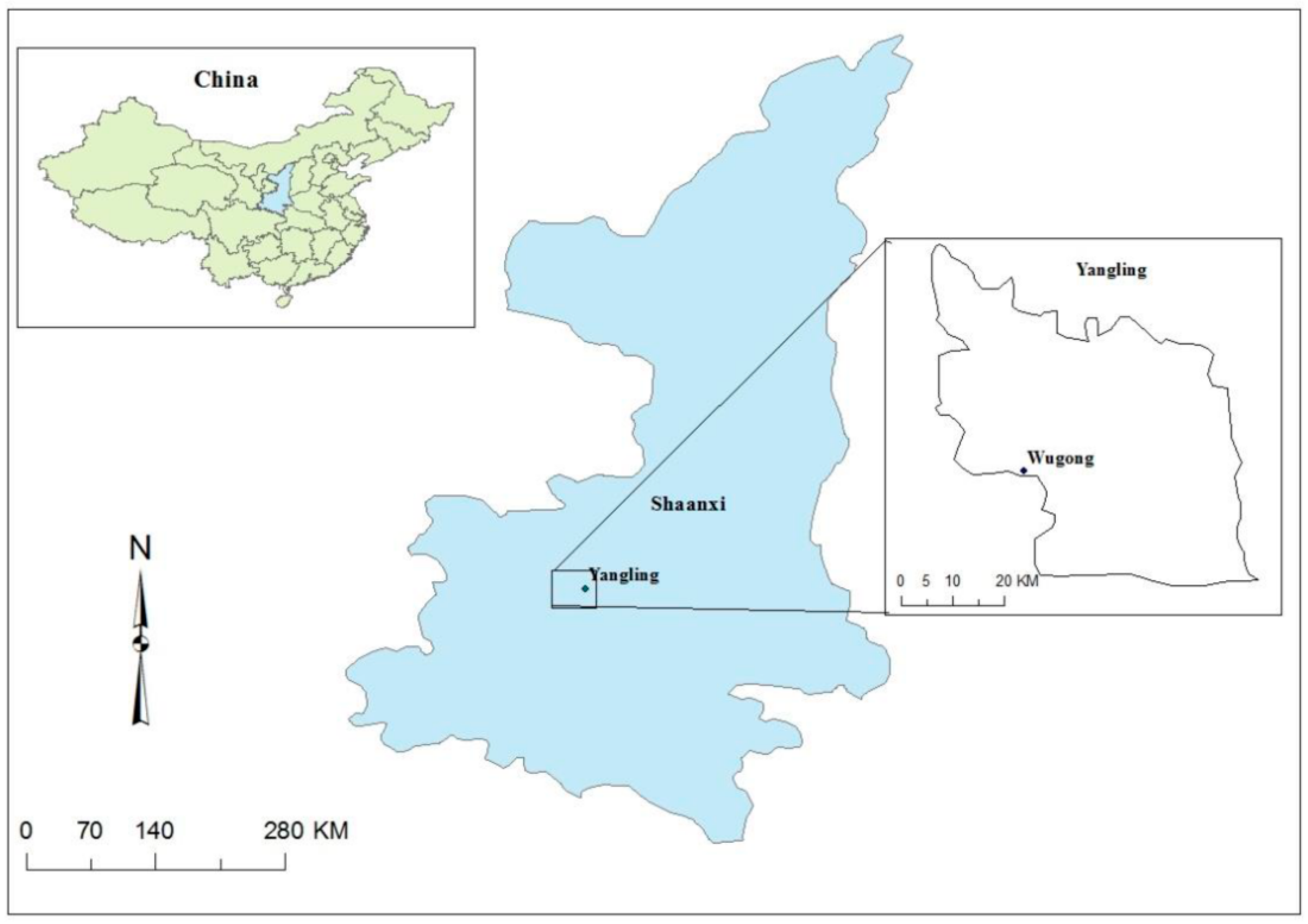
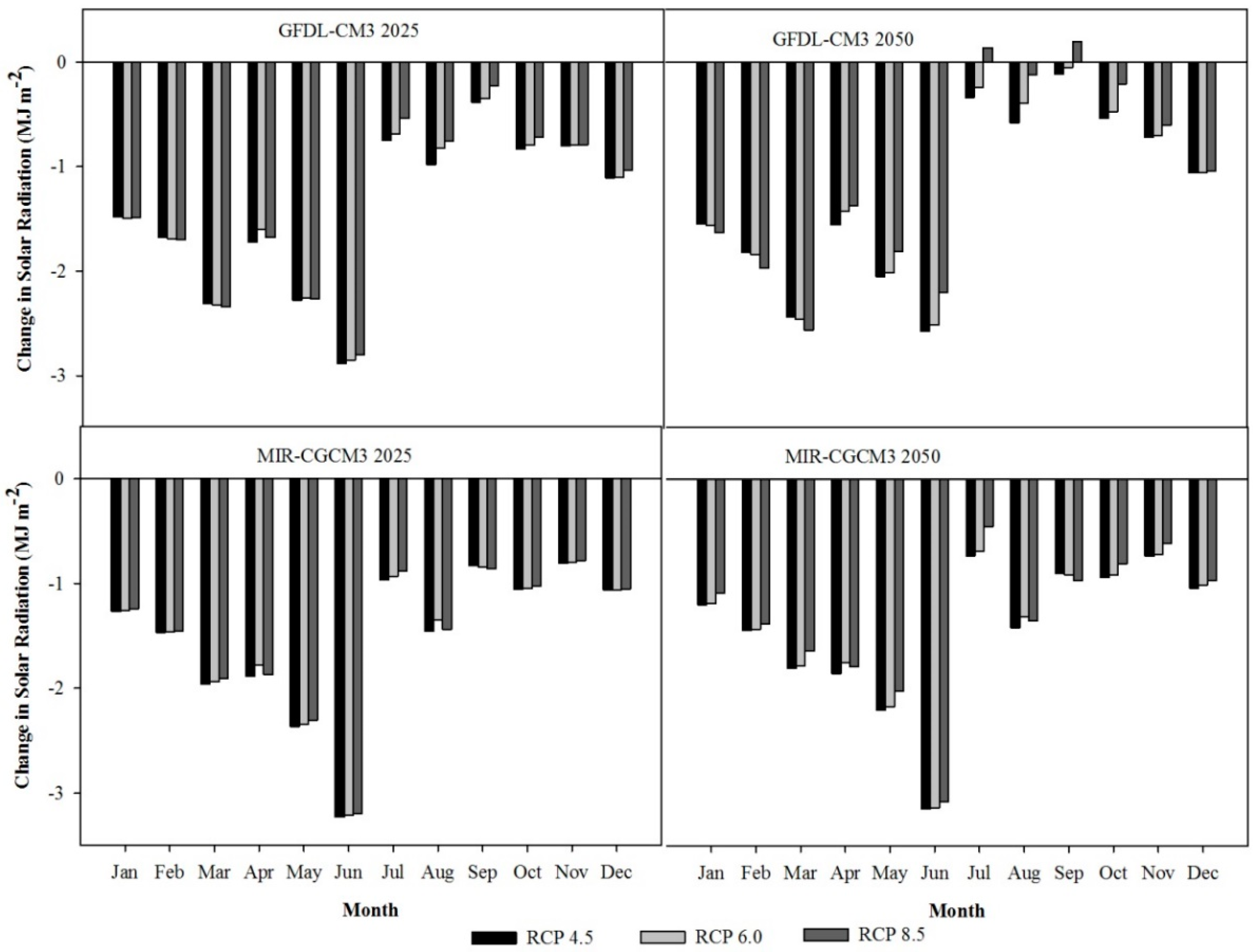
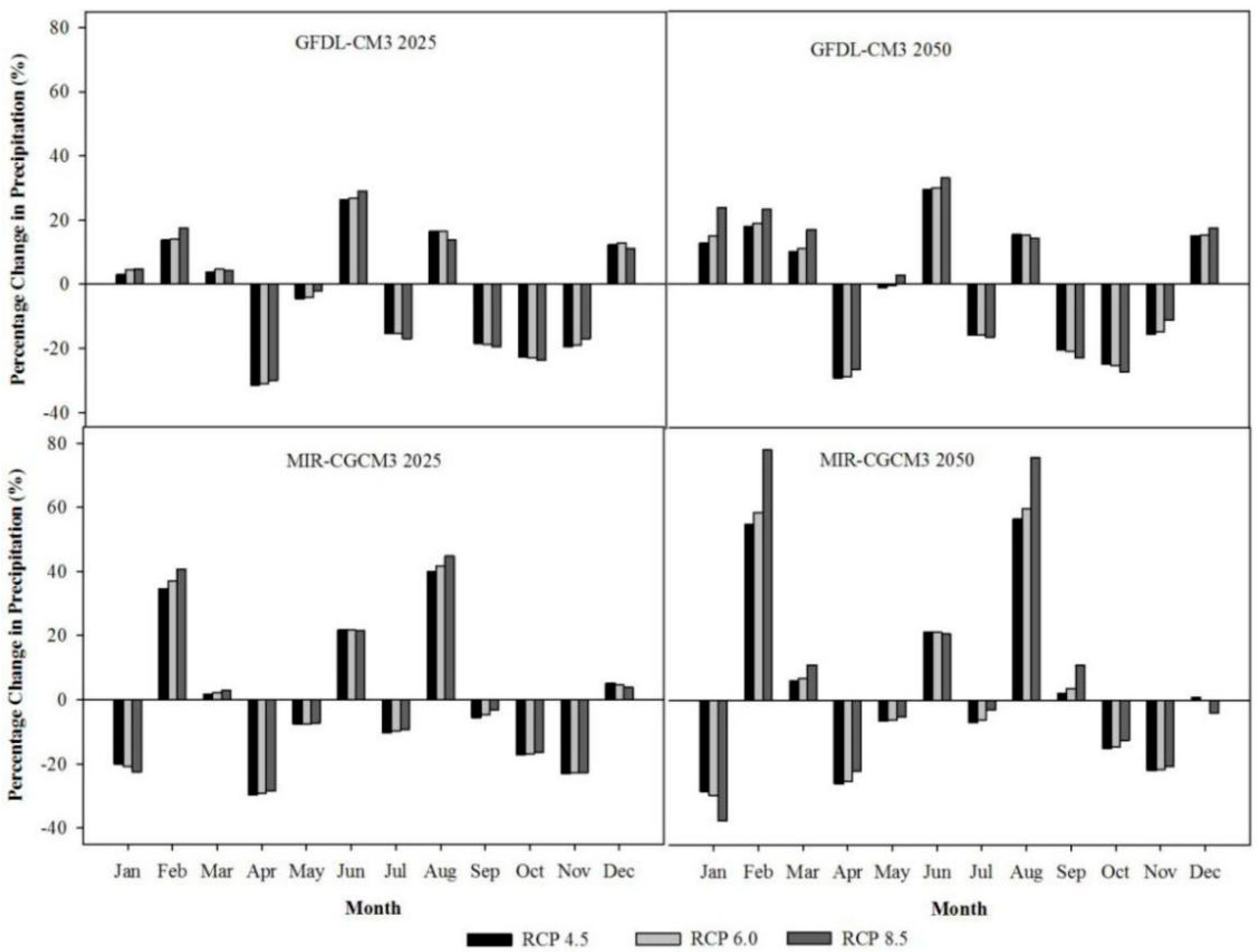
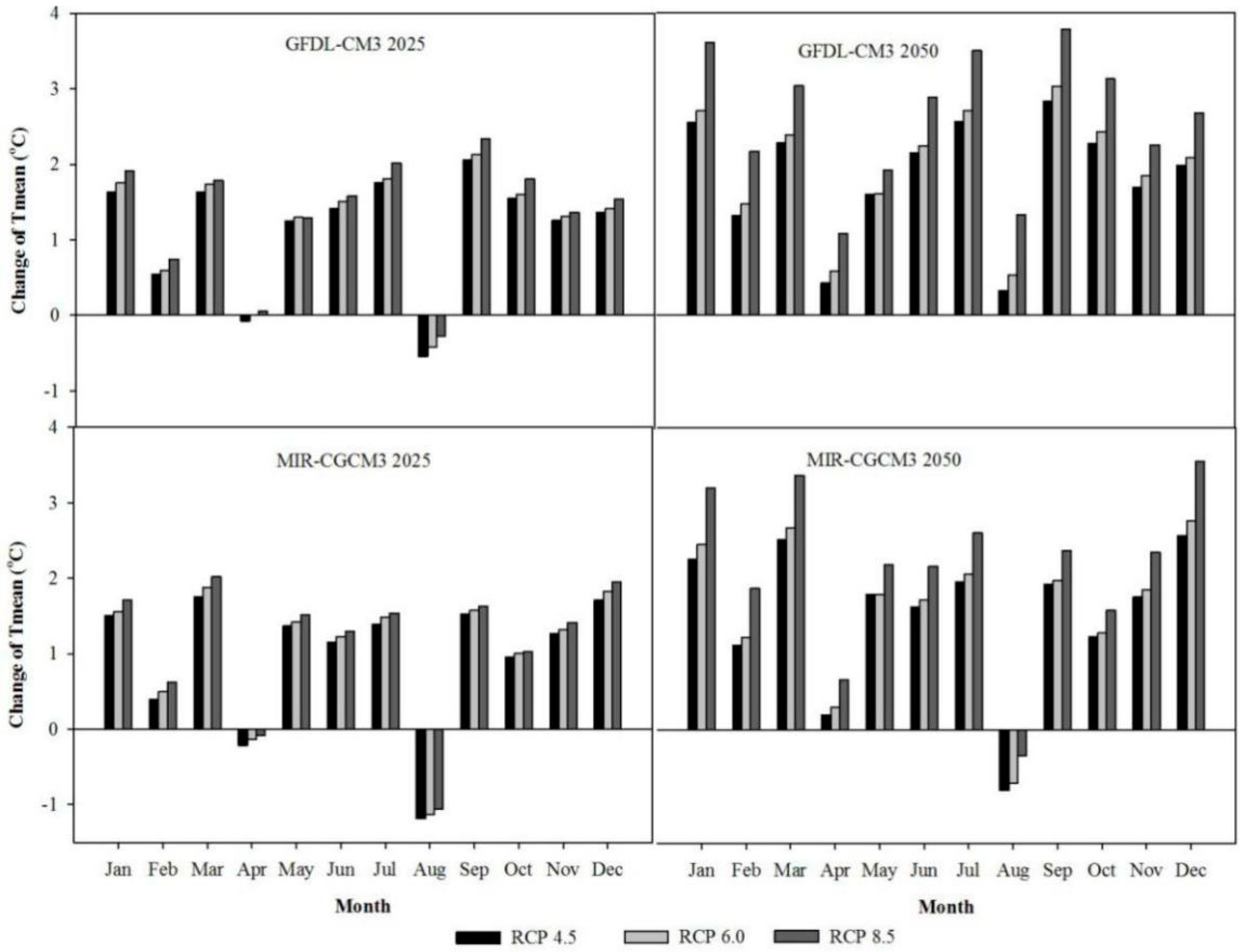
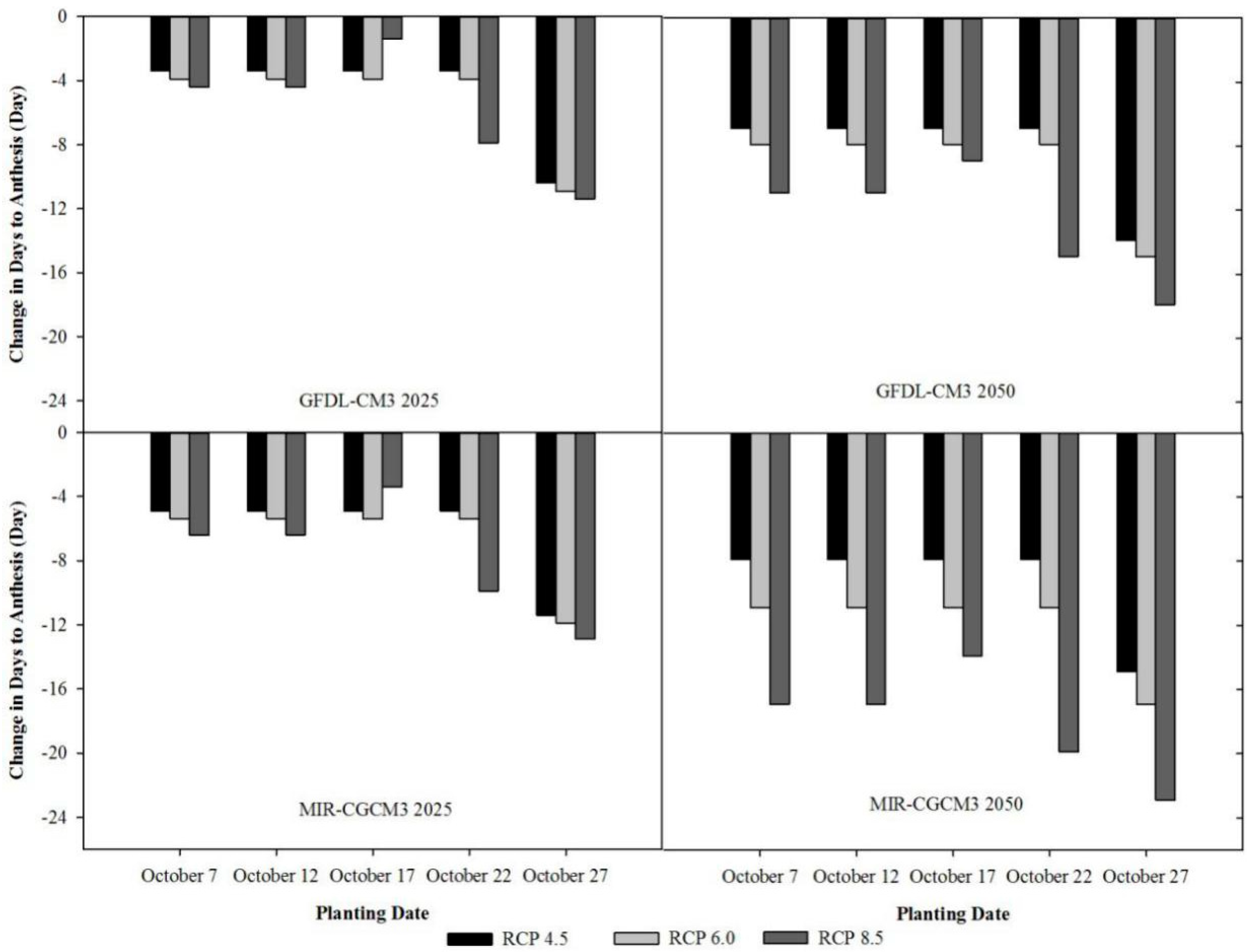

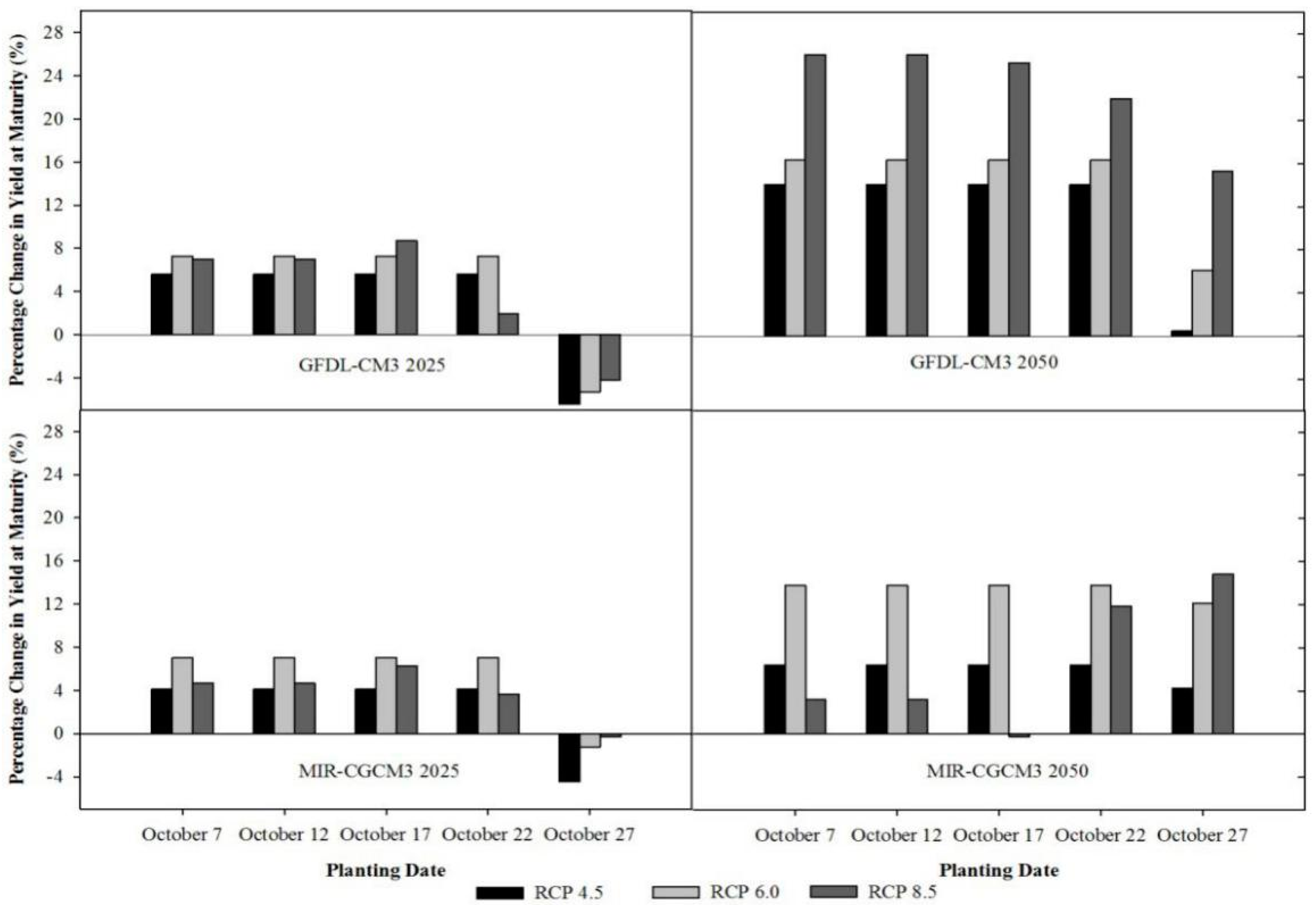
| Abbreviation | Definition | Unit | Value |
|---|---|---|---|
| P1V | Vernalization sensitivity coefficient | degree-days | 6.62 |
| P1D | Photoperiod parameter | - | 81.37 |
| P5 | Grain filling phase duration | °C. d | 572.10 |
| G1 | Kernel number per unit canopy weight at anthesis | #/g | 23.30 |
| G2 | Potential kernel growth rate | mg | 33.70 |
| G3 | Standard, non-stressed dry weight (total, including grain) of a single tiller at maturity | g | 1.55 |
| PHINT | Thermal time between the appearance of leaf tips | °C. d | 97.20 |
| Depth (cm) | Bulk Density (g·cm−3) | Field Capacity | Wilting Moisture | Soil Texture (%) | ||
|---|---|---|---|---|---|---|
| sand | silt | clay | ||||
| 0–23 | 1.3 | 0.28 | 0.12 | 26.7 | 40.8 | 32.1 |
| 23–35 | 1.4 | 0.28 | 0.13 | 25.0 | 42.8 | 32.1 |
| 35–74 | 1.4 | 0.27 | 0.15 | 24.1 | 44.8 | 31.0 |
| 74–95 | 1.4 | 0.28 | 0.19 | 22.7 | 38.8 | 38.5 |
| 95–163 | 1.4 | 0.27 | 0.14 | 21.3 | 38.6 | 40.1 |
| 163–196 | 1.3 | 0.26 | 0.13 | 24.3 | 36.9 | 38.9 |
| Soil Depth (cm) | Wilting Point (cm3·cm−3) | Field Capacity (cm3·cm−3) | Saturation (cm3·cm−3) | Initial Water Content (cm3·cm−3) | NH4-N Conc. (g·Mg−1) | NO3-N Conc. (g·Mg−1) |
|---|---|---|---|---|---|---|
| 0–5 | 0.10 | 0.28 | 0.45 | 0.28 | 1.90 | 12.90 |
| 5–35 | 0.11 | 0.28 | 0.46 | 0.24 | 0.50 | 11.20 |
| 35–70 | 0.12 | 0.28 | 0.46 | 0.22 | 0.40 | 12.60 |
| 70–90 | 0.14 | 0.28 | 0.49 | 0.22 | 0.60 | 11.80 |
| 90–100 | 0.14 | 0.28 | 0.50 | 0.23 | 0.60 | 10.50 |
| Planting Date | Projections | |||||||||||
|---|---|---|---|---|---|---|---|---|---|---|---|---|
| GFDL-CM3 2025 | GFDL-CM3 2050 | MRI-CGCM3 2025 | MRI-CGCM3 2050 | |||||||||
| RCP 4.5 | RCP 6.0 | RCP 8.5 | RCP 4.5 | RCP 6.0 | RCP 8.5 | RCP 4.5 | RCP 6.0 | RCP 8.5 | RCP 4.5 | RCP 6.0 | RCP 8.5 | |
| 10.7 | 4216 | 4282.5 | 4271 | 4552 | 4643 | 5034 | 4157 | 4272 | 4178.5 | 4247 | 4542 | 4121 |
| 10.12 | 4216 | 4282.5 | 4271 | 4552 | 4643 | 5034 | 4157 | 4272 | 4178.5 | 4247 | 4542 | 4121 |
| 10.17 | 4216 | 4282.5 | 4340 | 4552 | 4643 | 5002 | 4157 | 4272 | 4243 | 4247 | 4542 | 3982 |
| 10.22 | 4216 | 4282.5 | 4068.5 | 4552 | 4643 | 4870 | 4157 | 4272 | 4137.5 | 4247 | 4542 | 4466 |
| 10.27 | 3734 | 3778.5 | 3824 | 4010 | 4235 | 4603 | 3814 | 3942 | 3979 | 4160 | 4477 | 4582 |
© 2020 by the authors. Licensee MDPI, Basel, Switzerland. This article is an open access article distributed under the terms and conditions of the Creative Commons Attribution (CC BY) license (http://creativecommons.org/licenses/by/4.0/).
Share and Cite
Zheng, Z.; Cai, H.; Wang, Z.; Wang, X. Simulation of Climate Change Impacts on Phenology and Production of Winter Wheat in Northwestern China Using CERES-Wheat Model. Atmosphere 2020, 11, 681. https://doi.org/10.3390/atmos11070681
Zheng Z, Cai H, Wang Z, Wang X. Simulation of Climate Change Impacts on Phenology and Production of Winter Wheat in Northwestern China Using CERES-Wheat Model. Atmosphere. 2020; 11(7):681. https://doi.org/10.3390/atmos11070681
Chicago/Turabian StyleZheng, Zhen, Huanjie Cai, Zikai Wang, and Xinkun Wang. 2020. "Simulation of Climate Change Impacts on Phenology and Production of Winter Wheat in Northwestern China Using CERES-Wheat Model" Atmosphere 11, no. 7: 681. https://doi.org/10.3390/atmos11070681
APA StyleZheng, Z., Cai, H., Wang, Z., & Wang, X. (2020). Simulation of Climate Change Impacts on Phenology and Production of Winter Wheat in Northwestern China Using CERES-Wheat Model. Atmosphere, 11(7), 681. https://doi.org/10.3390/atmos11070681




